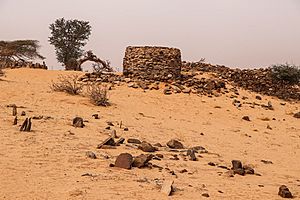Imam al-Hadrami facts for kids
Quick facts for kids Al-Imam al-Hadrami |
|
|---|---|

The cenotaph of al-Hadrami at Azougui
|
|
| Religion | Islam |
| Personal | |
| Nationality | Ifriqiya |
| Born | Kairouan |
| Died | 1095 Azougui, Almoravid Dynasty |
Abū Bakr Muḥammad ibn al-Ḥasan al-Murādī al-Ḥaḍramī (Arabic: أبو بكر محمد بن الحسن المرادي الحضرمي), also known as Al-Hadrami, was an important Islamic scholar and legal expert from North Africa. He lived in the 11th century and was known for his writings on religion and how to govern well. He passed away in 1095.
Contents
Al-Hadrami's Life Story
Al-Hadrami was born in the city of Kairouan, which is in modern-day Tunisia. His family came from the Hadramawt region in southern Arabia. He received his education in his hometown, studying with many teachers, including Abu Imran al-Fasi. Records show that Al-Hadrami also spent a short time studying in Córdoba in 1094.
After the Almoravid group conquered Azougui, a city near Atar in modern-day Mauritania, Al-Hadrami moved there with their leader, Abu Bakr ibn Umar. In Azougui, he worked as a qadi, which is like a judge, until he died in 1095.
His Writings and Ideas
Al-Hadrami wrote several books about religious ideas and how to run a government. His most famous work that still exists today is called Kitâb al-Ishâra. This book is like a guide for leaders, giving advice on how to be a good ruler.
It covers many topics, such as:
- How to govern fairly.
- How to choose good advisors and friends.
- How to lead soldiers in battle.
- When to show mercy and forgiveness.
Al-Hadrami's Lasting Legacy
Long after Al-Hadrami died, his memory became very important in Mauritania. This started in the late 1600s when his grave in Azougui was "rediscovered." People began telling stories about him, saying he was a wise and holy person who could perform miracles.
Local stories say that Al-Hadrami played a big part in the Almoravid group taking over Azougui. The people living in Azougui at that time, called the Bafour, used hunting dogs against their enemies. Because of this, the town was known as Madinat al-Kilab, which means City of Dogs. According to these stories, Al-Hadrami somehow stopped these dogs, which helped the Almoravids conquer the area, even though he died during the battle. His tomb was "rediscovered" again in the 1700s.
Today, Al-Hadrami's tomb is still a respected place in the cemetery near the old Almoravid ruins of Azougui. It is a simple stone structure without any fancy decorations.
Sources
- Paulo de Moraes Farias, The Almoravids: Some Questions Concerning the Character of the Movement During its Period of closest Contact with the Western Sudan, Bulletin IFAN, série B,29, nº 3-4 (1967):794-878.
- Mustapha Naïmi, La dynamique des alliances ouest-sahariennes, (in French) ISBN: 978-2735110605.
- Pierre Bonté, Figures historiques de sainteté dans la société maure (in French) Retrieved 12 April 2020.
See also
 In Spanish: Al-Imam al-Hadrami para niños
In Spanish: Al-Imam al-Hadrami para niños

